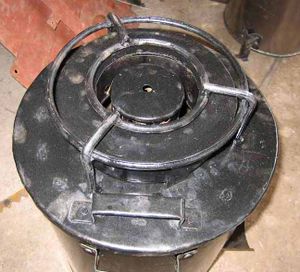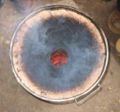
In many developing countries there are large amounts of waste sawdust from timber processing. The sawdust can not be reliably burned in normal stoves or open fires, but a stove design by the Kisangani Smith Group (KSG) of Tanzania allows it to be used as a fuel for cooking. In 2008 KSG won an Ashden Award for their work.
Stove design and manufacture[edit | edit source]
The stove is cylindrical, about 420 mm tall and 270 mm in diameter, with feet to raise it off the ground. The lid of the stove has a heat-spreader and pot support, and at one side an entry port at the base serves as the air inlet. This inlet also allows a small amount of wood to be introduced, which is useful for getting the stove started and sometimes for controlling the burn rate as well. The heat spreader, mounted on the lid of the stove, has a complex shape to direct heat over the whole of the pot base and prevents localised heating. The lid fits tightly over the cylindrical stove body, and a serrated flange on the underside of this lid sinks into the sawdust and prevents hot gases from escaping sideways. A pole guide, used for filling the stove (see below), is welded in the centre of the cylindrical cavity. The finished metal stove is normally painted before sale.
The parts for the stove are cut by hand from mild steel sheet. A set of 13 templates enables the parts to be quickly cut to a standard design using hand or bench shears. Most parts are hammered into shape, using simple formers, and joints are made from folding the metal and then hammering it securely. Rivets are used to attach the handles and feet.
Using the stove[edit | edit source]
Prior to use, the stove is filled with sawdust. A wooden pole is located in the guide in the centre of the stove body and sawdust is poured in and pushed down by hand. It is then rammed in hard with a specially designed tool, reducing the volume by about 30%. The stove is then topped up with sawdust and compressed again until it is as full as possible. Finally, the wooden pole is carefully removed, leaving an internal 'chimney' connected to the air entry port at the base.
-
Filling with sawdust.
-
Compacting the sawdust.
Small pieces of wood are put in the entry port and set alight, and the fire is left for about five minutes to become established. The lid is then placed on top, so that the serrated flange is pressed firmly into the sawdust. The stove can then be left largely unattended until the sawdust has completely burned, although (depending on the type of sawdust) it may be necessary to add a small amount of wood in the entry port from time to time.
The sawdust gradually burns away at the bottom and chars at the top. Although the combustion process has not been studied in detail, it is likely that secondary air mixes with the hot gases coming through the heat spreader, and enables these gases to be burned as well, increasing the overall efficiency and reducing emissions. One load of sawdust can burn slowly for up to six hours, so that several pots of food can be cooked and water for washing heated at the end. The expected stove life is three to five years: some early prototypes have been in use for five years.
-
Lighting the stove.
-
Sawdust burning inside the stove.
-
Cooking on the stove.
User support[edit | edit source]
New users receive an instruction leaflet explaining how to use their stove. KSG has held training sessions, but new users find them easy to use even without formal training. The heat spreader on the sawdust stove is the part that sometimes fails, prompting retailers to ask KSG for replacements. KSG supplies new parts or the materials for a local blacksmith to make them.
Cost of the stove[edit | edit source]
The retail price of the sawdust stove is about 35,000 TSh (£16) and the wood stove 30,000 TSh (£14). These prices are rising due to the increasing price of mild steel sheet. Stoves are sold mainly through retailers, who place bulk orders with KSG at trade fairs and are given a small discount on the price. Purchasers pay for their stoves in full in cash: no credit system is offered by KSG.
Benefits of the stove[edit | edit source]
Most sawdust stoves have been purchased by householders for cooking family meals. The main motivation to buy such a stove is to save the cost of charcoal. A family cooking with charcoal typically uses about two standard 70 kg sacks per month, costing 5,000 TSh each, or 10,000 TSh (£4.50) in total, and sawdust replaces virtually all this use. The sawdust is free, so the time to repay the cost of the stove through charcoal savings is three to four months. Café owners report that they save about four to six sacks of charcoal per month (20,000 to 30,000 TSh) so for them the stove easily pays for itself within two months.
Another feature which users really appreciate is saving time, because food cooks much more quickly on a sawdust stove than on an open fire or charcoal stove. The stove also heats up more quickly, so it becomes possible to prepare hot food and hot drinks in the morning as well as the evening. In addition, once the stove has been filled and lit, it can be safely left virtually unattended, whereas a wood stove or charcoal stove needs frequent checking and re-fuelling. The stove will continue producing heat for six hours or more, before it needs to be refilled, and most people fill the stove only once or twice per day. Women also report less eye irritation and respiratory problems, and just like using the stove.
People also buy wood stoves to reduce the amount of time needed for collecting fuelwood. This is a heavy burden, and usually undertaken by women.
There are also environmental benefits from reducing the use of charcoal or fuelwood, which helps reduce deforestation and carbon emissions.
Notes[edit | edit source]
Information in this article has been supplied by the Ashden Awards, and is used here with full permission.




